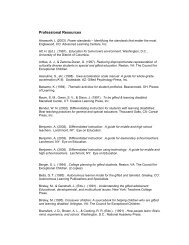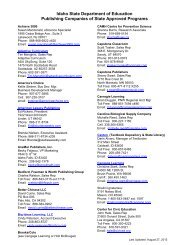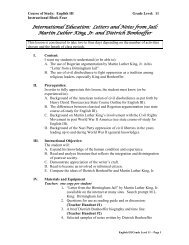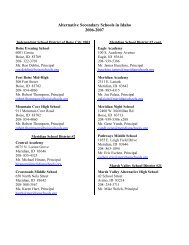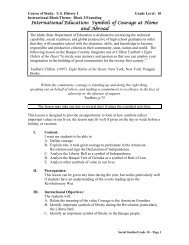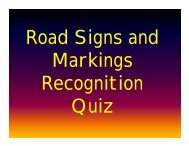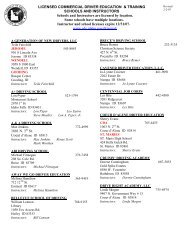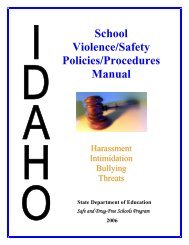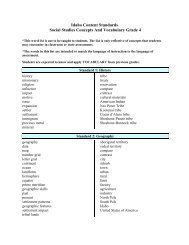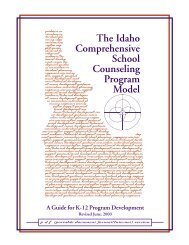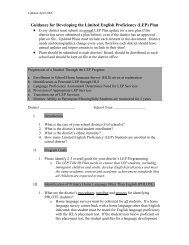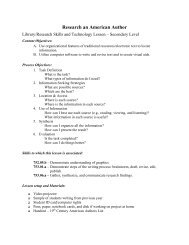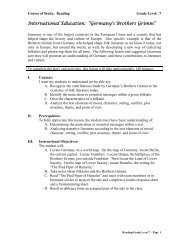formative assessment: examples of practice - Council of Chief State ...
formative assessment: examples of practice - Council of Chief State ...
formative assessment: examples of practice - Council of Chief State ...
Create successful ePaper yourself
Turn your PDF publications into a flip-book with our unique Google optimized e-Paper software.
FORMATIVE ASSESSMENT:<br />
EXAMPLES OF PRACTICE<br />
A WORK PRODUCT INITIATED AND LED BY<br />
E. CAROLINE WYLIE, ETS<br />
Paper prepared for the Formative Assessment for Teachers and Students (FAST)<br />
<strong>State</strong> Collaborative on Assessment and Student Standards (SCASS) <strong>of</strong> the<br />
<strong>Council</strong> <strong>of</strong> <strong>Chief</strong> <strong>State</strong> School Officers (CCSSO)
THE COUNCIL OF CHIEF STATE SCHOOL OFFICERS<br />
The <strong>Council</strong> <strong>of</strong> <strong>Chief</strong> <strong>State</strong> School Officers (CCSSO) is a nonpartisan, nationwide, nonpr<strong>of</strong>it organization <strong>of</strong> public <strong>of</strong>ficials who head<br />
departments <strong>of</strong> elementary and secondary education in the states, the District <strong>of</strong> Columbia, the Department <strong>of</strong> Defense Education Activity,<br />
and five U.S. extra-state jurisdictions. CCSSO provides leadership, advocacy, and technical assistance on major educational issues. The<br />
<strong>Council</strong> seeks member consensus on major educational issues and expresses their views to civic and pr<strong>of</strong>essional organizations, federal<br />
agencies, Congress, and the public.<br />
Formative Assessment for Students and Teachers<br />
<strong>State</strong> Collaborative on Assessment and Student Standards<br />
The <strong>Council</strong>’s <strong>State</strong> Collaborative on Assessment and Student Standards (SCASS) strives to provide leadership, advocacy and service in<br />
creating and supporting effective collaborative partnerships through the collective experience and knowledge <strong>of</strong> state education personnel<br />
to develop and implement high standards and valid <strong>assessment</strong> systems that maximize educational achievement for all children.<br />
COUNCIL OF CHIEF STATE SCHOOL OFFICERS<br />
Rick Melmer (South Dakota), President<br />
Elizabeth Burmaster (Wisconsin), Past President<br />
T. Kenneth James (Arkansas), President-Elect<br />
Gene Wilhoit, Executive Director<br />
John Tanner, Director Center for Innovative Measures<br />
Douglas Rindone and Duncan MacQuarrie, Co-Coordinators, FAST SCASS<br />
<strong>Council</strong> <strong>of</strong> <strong>Chief</strong> <strong>State</strong> School Officers<br />
One Massachusetts Avenue, NW, Suite 700<br />
Washington, DC 20001-1431<br />
Phone (202) 336-7000<br />
Fax (202) 408-8072<br />
www.ccsso.org<br />
Copyright © 2008 by the <strong>Council</strong> <strong>of</strong> <strong>Chief</strong> <strong>State</strong> School Officers, Washington, DC<br />
All rights reserved.
FORMATIVE ASSESSMENT: EXAMPLES OF PRACTICE<br />
FORMATIVE ASSESSMENT: EXAMPLES OF PRACTICE<br />
A WORK PRODUCT INITIATED AND LED BY E. CAROLINE WYLIE, ETS, FOR<br />
THE CCSSO FORMATIVE ASSESSMENT FOR STUDENTS AND TEACHERS (FAST) SCASS<br />
The purpose <strong>of</strong> this document is to share some <strong>examples</strong> <strong>of</strong> the <strong>Council</strong> <strong>of</strong> <strong>Chief</strong> <strong>State</strong> School Officers’<br />
(CCSSO) definition <strong>of</strong> <strong>formative</strong> <strong>assessment</strong> in <strong>practice</strong> 1 . The CCSSO definition <strong>of</strong> <strong>formative</strong> <strong>assessment</strong><br />
developed and approved by the CCSSO Formative Assessment Advisory Group and Formative<br />
Assessment for Teachers and Students (FAST) SCASS is presented below:<br />
Formative <strong>assessment</strong> is a process used by teachers and students during instruction<br />
that provides feedback to adjust ongoing teaching and learning to improve students’<br />
achievement <strong>of</strong> intended instructional outcomes.<br />
The following are five attributes based on current literature that render <strong>formative</strong> <strong>assessment</strong> most<br />
effective.<br />
Learning Progressions<br />
Learning progressions should clearly articulate the sub-goals <strong>of</strong> the ultimate learning goal.<br />
Learning Goals and Criteria for Success<br />
Learning goals and criteria for success should be clearly identified and communicated to students.<br />
Descriptive Feedback<br />
Students should be provided with evidence-based feedback that is linked to the intended instructional outcomes and<br />
criteria for success.<br />
Self- and Peer-Assessment<br />
Both self- and peer-<strong>assessment</strong> are important for providing students an opportunity to think meta-cognitively about<br />
their learning<br />
Collaboration<br />
A classroom culture in which teachers and students are partners in learning should be established.<br />
It is important that the reader first recognize <strong>formative</strong> <strong>assessment</strong> and what it is not before developing a more<br />
nuanced understanding <strong>of</strong> <strong>formative</strong> <strong>assessment</strong>. This is akin to learning to appreciate jazz. The first step is to be<br />
able to distinguish jazz from blue grass or funk. Recognizing the broad genre is an important prerequisite before<br />
moving on to learn about how the various aspects <strong>of</strong> jazz music such as blue notes, call-and-response, improvisation,<br />
and syncopation all work together to create a musical performance.<br />
Therefore, there are two sets <strong>of</strong> vignettes. The first set provides very brief <strong>examples</strong> and counter-<strong>examples</strong> <strong>of</strong><br />
<strong>formative</strong> <strong>assessment</strong>. The second set illustrates extended <strong>examples</strong> <strong>of</strong> <strong>formative</strong> <strong>assessment</strong> <strong>practice</strong>s and the<br />
interconnectedness <strong>of</strong> the various attributes. The vignettes are taken from teacher observations conducted in a<br />
variety <strong>of</strong> schools across the U.S. These vignettes illustrate <strong>formative</strong> <strong>assessment</strong> <strong>practice</strong> across a range <strong>of</strong> grade<br />
levels and content areas. Each vignette provides a description <strong>of</strong> the classroom activities, followed by a brief<br />
analysis that relates the actions <strong>of</strong> the teacher and students to one or more <strong>of</strong> the five attributes <strong>of</strong> effective <strong>formative</strong><br />
<strong>assessment</strong>. Note that a particular <strong>formative</strong> <strong>assessment</strong> <strong>practice</strong> may not exemplify all five attributes.<br />
1 Grateful thanks go to the various members <strong>of</strong> the FAST SCASS who contributed <strong>examples</strong> <strong>of</strong> <strong>formative</strong> <strong>practice</strong> and provided<br />
feedback on various iterations <strong>of</strong> this document.<br />
THE COUNCIL OF CHIEF STATE SCHOOL OFFICERS<br />
3<br />
THE FAST SCASS • FORMATIVE ASSESSMENT FOR TEACHERS AND LEARNERS
FORMATIVE ASSESSMENT: EXAMPLES OF PRACTICE<br />
VIGNETTE SET A:<br />
IS IT OR ISN’T IT FORMATIVE ASSESSMENT?<br />
Set A contains short descriptions <strong>of</strong> classroom<br />
<strong>practice</strong>. After each vignette, a brief rationale is<br />
provided as to why it is or is not <strong>formative</strong><br />
<strong>assessment</strong>.<br />
Vignette 1: Thumps Up and Thumbs<br />
Down<br />
A high-school biology teacher frequently reads<br />
aloud a prepared biology-related statement, then asks<br />
students to hold their hands under their chins and<br />
signify whether the statement is true or false by<br />
showing a “thumbs-up” for true or a “thumbs-down”<br />
for false. Depending on the number <strong>of</strong> students who<br />
respond incorrectly the teacher may have students<br />
present arguments for both sides, he may pair<br />
students and ask them to discuss the concept further,<br />
or he may decide that he needs to present the same<br />
concept using a different representation or<br />
instructional approach.<br />
This teacher is using a <strong>formative</strong> <strong>assessment</strong><br />
approach to collect evidence to adjust instruction.<br />
This is, therefore, an instance <strong>of</strong> <strong>formative</strong><br />
<strong>assessment</strong>.<br />
Vignette 2: Structured Pair-Work<br />
Each student is given an appointment clock and<br />
is required to make an appointment with three other<br />
students for discussion later in the lesson. Once all<br />
the appointments have been made the teacher begins<br />
the lesson, providing information and posing<br />
questions that require higher-order thinking about the<br />
information. The students are asked to reflect on the<br />
information and to answer specific questions. Then<br />
the students go to their first appointment and spend<br />
approximately 15 minutes sharing their thinking as it<br />
relates to one or two <strong>of</strong> the posed questions. They<br />
analyze each other’s responses and come to<br />
consensus. As the students work with their partners,<br />
the teacher walks around and notes common<br />
misunderstandings and gaps in understanding. At the<br />
conclusion <strong>of</strong> the first appointment, the teacher uses<br />
the information gained during the informal<br />
observations to help redirect thinking, to reinforce<br />
ideas, and to provide cues that would help advance<br />
their learning. The students then go to their next<br />
appointment and class continues in this manner until<br />
all appointments have been met and all questions<br />
have been discussed.<br />
This is an example <strong>of</strong> <strong>formative</strong> <strong>assessment</strong><br />
where the posed questions and the peer conversations<br />
are used to elicit evidence <strong>of</strong> the students'<br />
understandings. In this context, the <strong>formative</strong><br />
<strong>assessment</strong> process is embedded into the learning<br />
activity itself due to the teacher’s careful engineering<br />
<strong>of</strong> the activity. The students are able to self-reflect<br />
and get feedback from their peers. The teacher is<br />
able to listen to the conversations between students to<br />
note the current level <strong>of</strong> understanding for the class<br />
and for individual students. The teacher uses the<br />
information immediately to assist students in their<br />
learning by redirecting thinking, reinforcing ideas, or<br />
providing cues.<br />
Vignette 3: Collective Definitions <strong>of</strong><br />
Success Criteria<br />
The teacher provides students with an openended<br />
question related to a concept they are studying<br />
and asks the students to identify the information or<br />
details necessary for a response to demonstrate full<br />
understanding <strong>of</strong> the concept. A list <strong>of</strong> these details is<br />
recorded on the board. The teacher then provides<br />
students with <strong>examples</strong> <strong>of</strong> several student responses<br />
that were given by students in previous years. The<br />
students are asked to analyze the responses and to<br />
determine if the responses show full understanding,<br />
partial understanding, or no understanding <strong>of</strong> the<br />
concept. Students must justify their answers. As this<br />
thinking is shared, the list <strong>of</strong> details or supports<br />
necessary for a response to the question is further<br />
refined until a set <strong>of</strong> criteria emerges that students<br />
can use to self-assess and peer-assess their responses<br />
to the question.<br />
In this example <strong>of</strong> <strong>formative</strong> <strong>assessment</strong> the<br />
teacher is provided with information about student<br />
learning and the process used to gather that<br />
information also requires students to reflect on their<br />
own learning. This activity provides the teacher with<br />
information about how well the students understand<br />
the concept and how best to demonstrate that<br />
understanding. To fully participate in the activity,<br />
students must reflect on their own level <strong>of</strong><br />
understanding as they analyze the work <strong>of</strong> others and<br />
provide reasons why they think there are gaps in<br />
understanding.<br />
THE COUNCIL OF CHIEF STATE SCHOOL OFFICERS<br />
4<br />
THE FAST SCASS • FORMATIVE ASSESSMENT FOR TEACHERS AND LEARNERS
FORMATIVE ASSESSMENT: EXAMPLES OF PRACTICE<br />
Vignette 4: District-Developed<br />
Assessments<br />
District-developed monthly exams are to be<br />
administered to all students at the end <strong>of</strong> each <strong>of</strong> the<br />
school year’s first eight months. The exams are based<br />
on state-authorized curricular goals for the grade and<br />
subjects involved. Because district administrators<br />
insist that teachers send results <strong>of</strong> these tests home to<br />
parents, all teachers do so. Yet, because the content<br />
covered by the monthly tests typically doesn’t<br />
coincide with what is being taught at the time the<br />
tests are administered, teachers rarely alter their<br />
instruction based on students’ performances on the<br />
monthly exams.<br />
In this example, we see neither teachers’<br />
adjustment <strong>of</strong> their instruction nor students’<br />
adjustment <strong>of</strong> their learning tactics. Thus, this<br />
probably well-intentioned distribution <strong>of</strong> the monthly<br />
exams’ results to parents would constitute a counterexample<br />
<strong>of</strong> <strong>formative</strong> <strong>assessment</strong>.<br />
Vignette 5: Classroom Quizzes<br />
During a unit on photosynthesis, the teacher<br />
administers a weekly quiz that addresses all <strong>of</strong> the<br />
material covered for the week. The quizzes are<br />
supposed to motivate students to study for the<br />
summative unit as well as provide students with a<br />
sample <strong>of</strong> the types <strong>of</strong> questions they may encounter<br />
on the unit test.<br />
This is not an example <strong>of</strong> <strong>formative</strong> <strong>assessment</strong><br />
because the teacher does not use the evidence from<br />
the quizzes to adjust instruction, nor does the teacher<br />
provide direction to students for them to think metacognitively<br />
about their own learning. The only<br />
information the students receive is a score for the<br />
number <strong>of</strong> correct answers. This is an example <strong>of</strong><br />
ongoing summative <strong>assessment</strong>, not <strong>formative</strong><br />
<strong>assessment</strong>.<br />
VIGNETTE SET B:<br />
EXAMPLES OF FORMATIVE ASSESSMENT IN PRACTICE<br />
In this set the analysis relates each vignette back<br />
to the five attributes <strong>of</strong> effective <strong>formative</strong><br />
<strong>assessment</strong>. The attributes are characteristics or<br />
features <strong>of</strong> effective <strong>formative</strong> <strong>assessment</strong> that the<br />
literature suggests are important. As the vignettes<br />
illustrate, some instantiations <strong>of</strong> <strong>formative</strong><br />
<strong>assessment</strong> <strong>practice</strong> do not incorporate all <strong>of</strong> the<br />
attributes. For example, a particular vignette might<br />
not involve self- and peer-<strong>assessment</strong>, but it could<br />
still represent <strong>formative</strong> <strong>assessment</strong> <strong>practice</strong>.<br />
However, a teacher with a well-developed repertoire<br />
<strong>of</strong> <strong>formative</strong> <strong>assessment</strong> <strong>practice</strong>s incorporates selfand<br />
peer-<strong>assessment</strong>, as appropriate.<br />
These vignettes should not be viewed as<br />
complete descriptions <strong>of</strong> how particular teachers<br />
operationalize the concept <strong>of</strong> <strong>formative</strong> <strong>assessment</strong> in<br />
their classrooms, but rather illustrative <strong>of</strong> aspects <strong>of</strong><br />
that <strong>practice</strong>. One way to consider the vignettes is to<br />
focus on the ways that one attribute appears across<br />
multiple vignettes. For example, the vignettes can<br />
inform the reader about the many ways in which<br />
feedback can be used, or provide insight into<br />
variations in teacher and student collaborations.<br />
Vignette 1: Language Arts, Upper<br />
Elementary<br />
An upper elementary language arts teacher began<br />
the lesson by asking a series <strong>of</strong> planned questions<br />
about a story that students had just finished reading.<br />
The teacher first reminded the students about their<br />
reading learning goals for this week that focused on<br />
identifying the main idea and supporting details<br />
within a story. Her questions required careful<br />
analysis by the students, so the teacher structured her<br />
approach by asking students first to think about their<br />
answers as individuals and, then discuss their<br />
answers in small groups. Each group was to reach<br />
consensus on a single answer and that group answer<br />
was then shared with the rest <strong>of</strong> the class using<br />
Whiteboards that designated students held up. With<br />
this questioning and group work approach, the<br />
teacher was able to identify several groups <strong>of</strong><br />
students who were having difficulty understanding<br />
the concept. Summaries <strong>of</strong> the main idea <strong>of</strong> the story<br />
varied widely in accuracy and clarity. As the lesson<br />
was nearing the end, she asked the students to look at<br />
the various groups’ answers about the main idea, to<br />
select the one that they thought was the best answer,<br />
THE COUNCIL OF CHIEF STATE SCHOOL OFFICERS<br />
5<br />
THE FAST SCASS • FORMATIVE ASSESSMENT FOR TEACHERS AND LEARNERS
FORMATIVE ASSESSMENT: EXAMPLES OF PRACTICE<br />
and to write down why they made the choice they<br />
did. She had students answer using an Exit Ticket –<br />
index cards on which students wrote their individual<br />
answers and then handed to her as they left the<br />
classroom. This approach provided her with a quick<br />
way to review student thinking at the individual level,<br />
thus providing information that she could use to<br />
shape the next day's lesson.<br />
Several attributes <strong>of</strong> effective <strong>formative</strong><br />
<strong>assessment</strong> are illustrated in this vignette. As the<br />
teacher planned for this lesson to address the<br />
learning goal about the identification <strong>of</strong> the main<br />
idea, she developed a series <strong>of</strong> questions to ask her<br />
students. In addition, she planned a systematic way to<br />
allow students to think deeply about the questions,<br />
and to share their thinking with her and with<br />
members <strong>of</strong> the class. For this to be accomplished,<br />
the teacher had, over time, established a learning<br />
environment that emphasized collaboration: students<br />
were used to working in small groups and using<br />
whiteboards was part <strong>of</strong> the routine so that the<br />
teacher could use these evidence-gathering<br />
approaches with little explanation required. Finally,<br />
to support the impression developed during the<br />
lesson about group difficulties, the teacher was able<br />
to elicit evidence <strong>of</strong> student learning using Exit<br />
Tickets, an approach that required little time to<br />
review. With this student-level evidence <strong>of</strong><br />
understanding she was able to tailor her lesson the<br />
following day to capitalize on those students who had<br />
a deeper understanding <strong>of</strong> the learning goal. By<br />
incorporating various <strong>formative</strong> <strong>assessment</strong><br />
strategies during a single lesson, the teacher<br />
deepened her understanding <strong>of</strong> where her students<br />
were in their learning, and gathered evidence to<br />
inform her instructional decision making.<br />
Vignette 2: Mathematics, Upper<br />
Elementary<br />
A fifth grade mathematics teacher had been<br />
working with his students in the area <strong>of</strong> data analysis,<br />
and had recently introduced the class to the concept<br />
<strong>of</strong> using measures <strong>of</strong> central tendency to summarize<br />
data. He was aware <strong>of</strong> several <strong>of</strong> the typical<br />
misconceptions that students had about the concept <strong>of</strong><br />
“median.” In particular, he knew that students <strong>of</strong>ten<br />
did not think that ordering the numbers in a data set<br />
was a necessary first step, and that students <strong>of</strong>ten did<br />
not understand how to handle data sets with an even<br />
number <strong>of</strong> elements. He wrote two multiple-choice<br />
questions to address these common misconceptions.<br />
At the start <strong>of</strong> the lesson the teacher reviewed<br />
what they had covered in regards to measures <strong>of</strong><br />
central tendency. He also wrote the learning goal on<br />
the board: “Today we will learn how to select<br />
appropriate measures <strong>of</strong> central tendency.”<br />
Students had been using electronic clickers for<br />
the opening questions in mathematics class each<br />
morning. As a quick review <strong>of</strong> previous lessons, the<br />
teacher presented both multiple choice questions to<br />
the students. Almost all students answered the two<br />
questions correctly. He was about to begin to address<br />
the goal for that day’s lesson, when a student asked,<br />
“But there could be two answers, couldn’t there?” He<br />
asked the student to explain his reasoning to the<br />
class. The student explained that the problem could<br />
be solved in two ways – either select the middle<br />
number in the set, or put the numbers in order and<br />
then select the appropriate number. The teacher<br />
decided to poll the class and asked how many agreed<br />
with the student’s explanation <strong>of</strong> two possible<br />
answers. Just over half the class agreed that the<br />
problem could have two different answers.<br />
The teacher, on-the-fly, wrote up two identical<br />
data sets on the board, each with five terms, except<br />
one set was ordered and the other was not. He asked<br />
students to think on their own and then discuss with a<br />
partner to decide whether the two sets had the same<br />
median value. As students discussed this with a<br />
partner, the teacher circulated around the groups,<br />
making some notes <strong>of</strong> what he heard in the<br />
conversations. After about 10 minutes, he polled the<br />
class a second time, and now much fewer than half<br />
the students thought that the two sets had different<br />
medians. From the notes that the teacher took as he<br />
listened to students, he was able to identify several<br />
students who had very clear explanations for why the<br />
two sets had the same median value. He called on<br />
those students first to share their thinking with the<br />
class, and then asked students who disagreed to give<br />
their explanations. One student who had not<br />
previously been convinced by her partner shared her<br />
new understanding with the class. The teacher<br />
decided that the class was now ready to move on to<br />
the planned part <strong>of</strong> the lesson, but made a note to<br />
return to this problem for the class warm-up in a<br />
couple <strong>of</strong> days.<br />
Several attributes <strong>of</strong> effective <strong>formative</strong><br />
<strong>assessment</strong> are illustrated in this vignette. The<br />
teacher had a clear understanding <strong>of</strong> the learning<br />
progression that he wished to move students through<br />
on their way to learning the larger learning goal <strong>of</strong><br />
applying and interpreting measures <strong>of</strong> central<br />
tendency. He also was aware <strong>of</strong> common<br />
misconceptions that students have or develop in this<br />
particular area, and so created two questions to get<br />
at those misconceptions. Although students answered<br />
his questions correctly, he was still sensitive to the<br />
additional evidence provided by the one student who<br />
asked the question, and supplemented that evidence<br />
by a quick class poll. Realizing that although students<br />
THE COUNCIL OF CHIEF STATE SCHOOL OFFICERS<br />
6<br />
THE FAST SCASS • FORMATIVE ASSESSMENT FOR TEACHERS AND LEARNERS
FORMATIVE ASSESSMENT: EXAMPLES OF PRACTICE<br />
were able to complete the procedural steps to find the<br />
median value, they clearly did not understand the<br />
concept yet, he adjusted his instruction by creating<br />
an additional question for them to discuss in pairs.<br />
He continued to collect evidence systematically, both<br />
through listening to students’ conversation and<br />
through another poll. After facilitating and guiding<br />
students’ conversations the teacher decided that the<br />
class was ready to move on. However, he planned to<br />
return to this concept in a couple <strong>of</strong> days to check<br />
that the students had internalized the concept. This<br />
teacher used multiple sources <strong>of</strong> evidence in an<br />
effective way: planned questions at the start <strong>of</strong> the<br />
class; class polling to get a sense <strong>of</strong> the students’<br />
thinking; and listening to student conversation.<br />
Vignette 3: Mathematics, Middle<br />
School<br />
A middle school mathematics teacher established<br />
a start-<strong>of</strong>-class routine with her students that she<br />
called “Homework Help Board.” Twice a week the<br />
teacher would assign problems for students to<br />
complete as homework. As students came into class<br />
the following day, they would review their<br />
homework and identify any problems with which<br />
they had difficulty. They would write that problem<br />
number on the board. A student who had been able to<br />
successfully complete the question would write the<br />
solution on the board. This process was followed<br />
until all identified problems had correct solutions. If<br />
another student had a different approach to solving<br />
the same problem or a different answer, that student<br />
would post the alternative solution.<br />
If there were alternative correct solutions to any<br />
one problem, the teacher would point that out and ask<br />
students to discuss the different approaches. If<br />
something was incorrect, the teacher would ask the<br />
class if someone could correct the problem. If a<br />
problem had been noted on the board and no solution<br />
provided, the teacher would then review that<br />
problem, suggesting perhaps a first step or something<br />
to think about to see if a student, with support, could<br />
complete the solution. If all problems had a correct<br />
solution on the board, the teacher would either begin<br />
the lesson directly or perhaps ask one or two<br />
questions as a check to be certain all students<br />
understood the concepts.<br />
Usually the teacher was able to begin the lesson<br />
quite quickly as students had been able to resolve all<br />
the homework questions themselves. When students<br />
struggled to do this, she modified her instruction as<br />
necessary for that day or the following day in order to<br />
review or revisit the topic.<br />
This <strong>formative</strong> <strong>assessment</strong> example focuses<br />
primarily on the collaboration and self- and peer<strong>assessment</strong><br />
attributes <strong>of</strong> effective <strong>formative</strong><br />
<strong>assessment</strong>. Students had to self-assess their<br />
homework efforts, and the classroom culture<br />
emphasized collaboration so that students were<br />
willing to take a risk and share their approach to a<br />
problem that another student had encountered. This<br />
approach was a form <strong>of</strong> systematic data collection:<br />
the teacher was able to identify across the entire<br />
class which homework problems had caused<br />
difficulties. The teacher was able to decide whether<br />
to react to this information extemporaneously or<br />
whether a more detailed response in a subsequent<br />
lesson might be necessary. Either way, the<br />
information collected by the teacher would cause her<br />
to adjust instruction to improve student learning. The<br />
students’ solutions on the board also provided some<br />
teaching opportunities to have students think about<br />
multiple solution strategies, a particularly valuable<br />
approach when students use different representations<br />
to display their thinking.<br />
Vignette 4: Language Arts, Lower<br />
Elementary<br />
A lower elementary teacher had been working<br />
with his students on how to use the writing process to<br />
improve their own writing and to assist their peers.<br />
They were all working on writing personal stories<br />
around the topic <strong>of</strong> animals to publish in a class<br />
magazine. He introduced the idea <strong>of</strong> Two Stars and a<br />
Wish as a way <strong>of</strong> providing feedback which requires<br />
the reader to identify two positive aspects <strong>of</strong> the piece<br />
<strong>of</strong> work (the stars), and one specific suggestion for<br />
improvement (the wish). He began by explaining that<br />
the feedback he had given on their writing adhered to<br />
this very same principle. Now students would use the<br />
Two Stars and a Wish approach as they worked with<br />
each other in their writing groups. They discussed as<br />
an entire class the types <strong>of</strong> comments they might<br />
write when addressing positives aspects as well as<br />
comments to write when suggesting improvements.<br />
They also discussed the types <strong>of</strong> comments that<br />
would not be appropriate to write to a peer.<br />
The teacher then reminded students about their<br />
current writing project. He returned the writings to<br />
each student, and asked them to reread their essays<br />
and to review his comments. He then directed them<br />
to discuss with their partner the feedback given and<br />
specific ways they might improve on their next draft.<br />
During the student discussions, the teacher circulated<br />
the room, <strong>of</strong>fering suggestions to those who had<br />
difficulties planning their next steps.<br />
THE COUNCIL OF CHIEF STATE SCHOOL OFFICERS<br />
7<br />
THE FAST SCASS • FORMATIVE ASSESSMENT FOR TEACHERS AND LEARNERS
FORMATIVE ASSESSMENT: EXAMPLES OF PRACTICE<br />
During the next lesson, the students revised their<br />
work, and then began peer editing using the Two<br />
Stars and a Wish approach He reminded them <strong>of</strong> the<br />
conversation they had about appropriate and<br />
inappropriate comments, <strong>of</strong> the type <strong>of</strong> comments he<br />
had written, and <strong>of</strong> the purpose <strong>of</strong> writing these<br />
stories to share in the class magazine As students<br />
peer edited and provided feedback to their partners,<br />
the teacher again circulated the room and made<br />
suggestions, as necessary.<br />
The sharing <strong>of</strong> the feedback process was<br />
repeated and students then had an opportunity to<br />
make final revisions before submitting their final<br />
work for inclusion in the magazine.<br />
This example focuses on the following attributes<br />
<strong>of</strong> effective <strong>formative</strong> <strong>assessment</strong>: collaboration, the<br />
use <strong>of</strong> descriptive feedback and self- and peer<strong>assessment</strong>.<br />
The teacher introduced a new structure<br />
for the students to give feedback to each other. The<br />
collaboration between and among the teacher and<br />
the students was evident in the way that he modeled<br />
the feedback approach and also gave students an<br />
opportunity to think about appropriate and<br />
inappropriate comments to write. The feedback<br />
provided by the teacher not only modeled the<br />
approach, but also was part <strong>of</strong> the learning process.<br />
An important aspect <strong>of</strong> this instruction was that the<br />
teacher provided a structure for the students to<br />
review the feedback, and decide what they would do<br />
in the light <strong>of</strong> the feedback, using a peer as a<br />
sounding board, in order to stimulate action. Giving<br />
feedback without the time to react to it is <strong>of</strong> little<br />
value. When it was time for the students to analyze<br />
the writing <strong>of</strong> their peers, the teacher revisited the<br />
earlier discussion about the structure <strong>of</strong> Two Stars<br />
and a Wish and the types <strong>of</strong> appropriate feedback.<br />
The peer <strong>assessment</strong> was done in quite an informal<br />
way, without descriptions <strong>of</strong> performance levels, but<br />
the students had a clear purpose and audience for the<br />
writing, and the Two Stars and a Wish approach<br />
provided structure.<br />
Vignette 5: Science, Middle School<br />
A middle school science teacher decided that her<br />
eighth grade students were not benefiting as much as<br />
they could from the science inquiry experiments<br />
around which she structured her units. Her goal was<br />
that each week students would complete a lab report<br />
and, as part <strong>of</strong> the report, connect what they learned<br />
from the experiment to the “big ideas” that she was<br />
presenting throughout the unit. However, she realized<br />
that students were struggling with the lab report<br />
content, and she was spending much <strong>of</strong> her grading<br />
time commenting on earlier sections <strong>of</strong> the report<br />
rather than focusing on the connections that they<br />
were making to the big ideas. She had been using a<br />
“criteria-for-evaluation form” that described her<br />
expectations for the reports, but decided that it<br />
needed to be revised so that it was more easily<br />
understood by the students. Because the form was to<br />
be used by the students as they prepared their lab<br />
reports, she decided to allow the students help her in<br />
designing the new instrument.<br />
Before the start <strong>of</strong> the new school year, she<br />
pulled four student lab reports from the previous<br />
year, removing all identifying information. During<br />
the first class, she reviewed the criteria for evaluation<br />
form, and then handed out the four student reports.<br />
Working together in small groups, she asked the<br />
students to rank the reports, using the evaluation<br />
form, and to justify their ranking. A member <strong>of</strong> each<br />
group was randomly selected to explain his or her<br />
analysis <strong>of</strong> one <strong>of</strong> the reviewed reports. Other<br />
students were then allowed to add their comments.<br />
Once all four reports had been ranked and discussed<br />
by the class, she presented the rank order based on<br />
her grading <strong>of</strong> the reports and tied it back to the<br />
criteria-for-evaluation form. She responded to student<br />
questions about her scoring <strong>of</strong> the reports. She then<br />
reviewed again the purpose <strong>of</strong> the experiments and<br />
the write-ups, to help them better understand and<br />
make connections between their results and the big<br />
ideas <strong>of</strong> the course. She challenged the students to<br />
improve the criteria-for-evaluation form by creating<br />
their own check-lists that would help them do a better<br />
job on the lab reports.<br />
Students then went back to their small groups,<br />
and reviewed again the two higher scoring lab<br />
reports, against the criteria-for-evaluation form;<br />
discussed how to describe the important aspects <strong>of</strong><br />
the reports in their own words and from there<br />
developed their own list <strong>of</strong> important criteria. A<br />
second class period was spent compiling the ideas<br />
from each group, creating a final criteria list, and<br />
ensuring common understanding.<br />
For each lab report that students completed<br />
during the year, students were reminded to compare<br />
their own work against the criteria list as a first<br />
check. Then the teacher allowed 15 minutes <strong>of</strong> classtime<br />
each week, for students to exchange draft<br />
reports with another student and to provide feedback.<br />
Students used the criteria list as they peer-evaluated<br />
the reports and followed a 2 + 2 feedback strategy<br />
(two positives and two suggestions for improvement).<br />
Students then made any final revisions that evening<br />
before submitting final draft.<br />
The teacher discovered that students were better<br />
able to understand her expectations using the student<br />
developed criteria list, and that the quality <strong>of</strong> the lab<br />
reports increased significantly, along with greater<br />
depth <strong>of</strong> student thinking. Furthermore she was able<br />
THE COUNCIL OF CHIEF STATE SCHOOL OFFICERS<br />
8<br />
THE FAST SCASS • FORMATIVE ASSESSMENT FOR TEACHERS AND LEARNERS
FORMATIVE ASSESSMENT: EXAMPLES OF PRACTICE<br />
to spend more time focused on the connections that<br />
students were making to the big ideas which in turn<br />
was helping her plan her instruction better having a<br />
clearer sense <strong>of</strong> what they were still struggling with<br />
and what they understood.<br />
This <strong>formative</strong> <strong>assessment</strong> example focuses on<br />
several attributes including collaboration between<br />
and among teacher and students, and self- and peer<strong>assessment</strong>.<br />
The teacher structured her instruction<br />
around a learning progression, using a sequence <strong>of</strong><br />
inquiry experiments that were intended to help<br />
students develop understanding <strong>of</strong> several “big<br />
ideas”. Recognizing a weakness in her process, she<br />
engaged her students collaboratively to develop lab<br />
report criteria list that they clearly understood and<br />
that would help them improve the quality <strong>of</strong> their<br />
reports. Students were then encouraged to engage<br />
both in self-<strong>assessment</strong>, to monitor their own work<br />
against these criteria, and then to engage in peer<strong>assessment</strong><br />
by using the criteria to review the lab<br />
report <strong>of</strong> another student. Time was built into the<br />
regular classroom schedule allowing students time to<br />
incorporate the descriptive feedback before handing<br />
in their reports. In addition, as the quality <strong>of</strong> the<br />
reports improved, the teacher was able to attend<br />
more to the content that was most critical to the<br />
overall learning. As a result she was able to use that<br />
information to adjust teaching in the light <strong>of</strong> student<br />
learning.<br />
Vignette 6: Economics, High School<br />
An important concept in a high school<br />
economics curriculum is that <strong>of</strong> supply and demand.<br />
The high school economics teacher knew that his<br />
students needed to have a firm grasp <strong>of</strong> the five<br />
determinants <strong>of</strong> demand and the six determinants <strong>of</strong><br />
supply in order to understand how all the variables<br />
interacted to determine pricing.<br />
After introducing the five determinants <strong>of</strong><br />
demand, the teacher showed a movie clip from<br />
Hudsucker Proxy that shows a sudden change in<br />
price <strong>of</strong> a product due to a change in one <strong>of</strong> the five<br />
determinants. The teacher then asked students to<br />
identify which <strong>of</strong> the five determinants it was and to<br />
justify their response. From the student responses, the<br />
teacher was able to identify those who had<br />
understood the content and those who had not. He<br />
had an already-prepared worksheet for those who did<br />
not yet grasp the concept and he worked with this<br />
small group <strong>of</strong> students, using the worksheet to<br />
identify and address areas <strong>of</strong> misconception. Students<br />
who had answered the question correctly were able to<br />
begin the homework assignment which reinforced the<br />
concept covered in class while the teacher worked<br />
with the other group.<br />
The teacher repeated this process for the six<br />
determinants <strong>of</strong> supply, using a clip from Forest<br />
Gump, and again asking students to identify which<br />
determinant was involved. Again, he worked with the<br />
students who did not understand and allowed those<br />
who did to begin the reinforcement activity.<br />
The key attributes <strong>of</strong> effective <strong>formative</strong><br />
<strong>assessment</strong> in this vignette is that <strong>of</strong> the learning<br />
progressions. The teacher had a clear understanding<br />
<strong>of</strong> the learning progression that he wished to move<br />
students through in addition to the subsidiary<br />
learning goals within the topic. He anticipated key<br />
junctures in the unit on supply and demand and<br />
embedded an <strong>assessment</strong> point into his instruction<br />
that allowed him to quickly determine students’<br />
understanding <strong>of</strong> the determinants. Importantly, he<br />
had a plan <strong>of</strong> action prepared ahead <strong>of</strong> time <strong>of</strong> what<br />
he would do to support student learning both for<br />
those individuals who did not yet understand the<br />
content, and for those who did. If students did not<br />
grasp this concept, moving on to interpreting supply<br />
and demand graphs would be pointless.<br />
Vignette 7: History, High School<br />
A history teacher created an end-<strong>of</strong>-year research<br />
project for students to work on over a period <strong>of</strong><br />
several weeks. The goals <strong>of</strong> the project were to<br />
enable students to gain a broader perspective on<br />
domestic policy across 60 years <strong>of</strong> history, and to<br />
develop their research skills. Each group was<br />
assigned a different decade between the 1950’s and<br />
2000. Students were given guidelines regarding the<br />
structure <strong>of</strong> their 15-minute presentation as well as<br />
specific criteria for the study notes that they had to<br />
create. Each student within the group had to<br />
responsible for a piece <strong>of</strong> the presentation.<br />
The first step was for students to identify<br />
important policy issues for their assigned decade and<br />
to develop a research plan for deepening their<br />
understanding. Each group met with the teacher for<br />
feedback on their list <strong>of</strong> identified issues and their<br />
plan for tackling the project. Since the teacher wanted<br />
students to learn from each others’ presentations and<br />
notes, he met with each group on a regular basis to<br />
monitor progress, to give them an opportunity to<br />
reflect on their group’s progress and next steps, and<br />
to provide feedback on their presentations and draft<br />
notes. A few days before the final presentations were<br />
to be made, the groups were paired so that they could<br />
listen to each other’s dress-rehearsal presentations<br />
and give each other feedback on the notes, the<br />
content <strong>of</strong> the presentation and the delivery using the<br />
2+2 format to note two positive aspects and two<br />
aspects that could be improved. The teacher then met<br />
with each group to review the feedback they had<br />
THE COUNCIL OF CHIEF STATE SCHOOL OFFICERS<br />
9<br />
THE FAST SCASS • FORMATIVE ASSESSMENT FOR TEACHERS AND LEARNERS
FORMATIVE ASSESSMENT: EXAMPLES OF PRACTICE<br />
received and to discuss possible solutions to issues or<br />
concerns.<br />
The teacher created an end-<strong>of</strong>-project multiplechoice<br />
<strong>assessment</strong> that was based on the content<br />
across all the presentations. In addition, the year-end<br />
essay required students to analyze themes and<br />
patterns in domestic policies across the decades.<br />
This is an example <strong>of</strong> a complex project that<br />
required students to become experts in a particular<br />
decade so that they could teach their peers. This<br />
example illustrates how <strong>formative</strong> <strong>assessment</strong> is part<br />
<strong>of</strong> the balanced <strong>assessment</strong> approach. Because <strong>of</strong> the<br />
structure <strong>of</strong> the final summative <strong>assessment</strong><br />
(multiple-choice quiz and essay) students had to use<br />
the presentations <strong>of</strong> their peers and the study notes to<br />
become familiar with the major events, influences<br />
and policies <strong>of</strong> the other decades. Within the<br />
extended project there are multiple aspects <strong>of</strong><br />
effective <strong>formative</strong> <strong>assessment</strong> <strong>practice</strong>. The teacher<br />
monitored and guided student progress and gave<br />
students descriptive feedback along the way. He<br />
encouraged them to be self-reflective <strong>of</strong> their own<br />
progress and to use peer <strong>assessment</strong> strategies to<br />
give feedback to another group.<br />
incorrect fingerings were applied when students<br />
looked at each other's instruments and the correction<br />
was made immediately. A final check <strong>of</strong><br />
understanding required the students to play the<br />
measure again by holding each note and checking for<br />
correct pitches.<br />
This is an example <strong>of</strong> how small the grain-size <strong>of</strong><br />
a <strong>formative</strong> <strong>assessment</strong> can be. There is only a fine<br />
line between the instruction and the <strong>assessment</strong><br />
process so that the <strong>assessment</strong> is part <strong>of</strong> the<br />
instruction. In addition to working on playing the<br />
particular piece <strong>of</strong> music the teacher is also<br />
developing students’ musical ears so that they can<br />
identify problems, and then correct them. He<br />
encourages students to listen to each other and to<br />
observe each other in order to self-assess themselves.<br />
Vignette 8: Band/Orchestra, High<br />
School<br />
The band teacher worked through a section <strong>of</strong> a<br />
musical piece with the class that was selected<br />
because it contained several challenging sections that<br />
would require students to apply some <strong>of</strong> the recent<br />
lessons. As the band played through a particular<br />
measure <strong>of</strong> music he noticed a sour note. He stopped<br />
the group and asked whether anyone has noticed<br />
anything. Several students indicated that they noticed<br />
some <strong>of</strong>f-notes towards the end <strong>of</strong> the section. He<br />
then asked everyone to look at the second to last<br />
measure in the section. He asked everyone to play<br />
that measure and hold each note until directed to play<br />
the next one. By doing this he was able to help the<br />
students isolate the instruments that were playing the<br />
wrong pitch.<br />
On occasion this approach results in the students<br />
discovering for themselves that they are using an<br />
incorrect fingering. In this case students were still<br />
unsure about what exactly needed to be corrected.<br />
However, a couple <strong>of</strong> students volunteered to the<br />
class that they heard the wrong pitch in the trumpet<br />
section in the second beat <strong>of</strong> the measure. The<br />
teacher then asked the trumpets to hold up their<br />
instruments so he could see the valves and then hold<br />
down the fingering for the note(s) in the second beat<br />
<strong>of</strong> the measure. He then had the students observe the<br />
fingerings they had used. It was obvious where<br />
THE COUNCIL OF CHIEF STATE SCHOOL OFFICERS<br />
10<br />
THE FAST SCASS • FORMATIVE ASSESSMENT FOR TEACHERS AND LEARNERS



